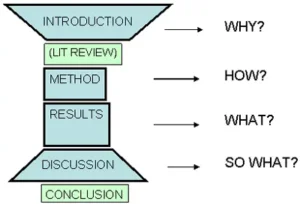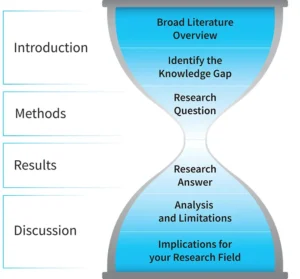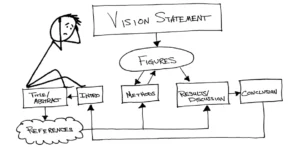In the bustling laboratory of Andrea Jorden at the University of Southern California, a diverse group of students collaborates at the forefront of scientific innovation. With up to 15 Ph.D. students, postdocs, undergrads, and even the occasional high school enthusiast, the atmosphere is charged with the excitement of developing cutting-edge materials for diagnostic and telecommunications devices.
Amidst this dynamic backdrop, Jorden, a seasoned researcher, imparts a unique philosophy—testing hypotheses rather than seeking unwavering proof. She seeks students with the courage to embrace the unknown, encouraging them to push their limits and the boundaries of their field. She insists failure is not a roadblock but a stepping stone to valuable lessons.
Jorden’s mentorship extends beyond the laboratory, guiding students through the intimidating realm of crafting their first science research paper. Facing the daunting blank page post-study, she introduces a 10-step formula—a beacon of guidance for those grappling with uncertainty.
As we weave through this narrative of scientific exploration, the importance of research paper topics becomes evident. These topics, like the threads in Jorden’s laboratory, shape the fabric of scientific inquiry. In this tale of discovery, each chosen topic contributes to the evolving symphony of knowledge, making the selection a pivotal aspect of the scientific journey.
Unlocking Discovery: Jorden’s Science Research Paper Guide
1. Preliminary Work: Setting the Stage for Success
Before embarking on the writing process, the preliminary work serves as the foundational groundwork that significantly influences the success of a scientific research paper. This phase is particularly critical during the protocol preparation stage of a research project. Meticulous attention is given to defining three key elements: background, significance, and objectives.
- Define Background: This involves providing a comprehensive understanding of the context in which the research is situated. Researchers need to delve into existing literature, identify gaps in knowledge, and articulate the current state of the field. By doing so, they set the stage for their own contribution and demonstrate awareness of the broader scientific landscape.
- Establish Significance: Clearly outlining the significance of the research is essential. Researchers should articulate why their work matters, identifying potential implications for the scientific community, practical applications, or theoretical advancements. This step helps establish the relevance and impact of the research.
- Set Objectives: Defining clear and concise research objectives is crucial for guiding the entire study. These objectives serve as a roadmap, outlining the specific goals the research aims to achieve. Well-defined objectives contribute to a focused and purposeful research process.
2. Understanding the Structure: IMRAD Format

The IMRAD format, an acronym for Introduction, Methods, Results, and Discussion, serves as a standardized and widely accepted structural framework for science research papers. Adhering to this format is essential, as it not only provides a logical flow to the paper but also aligns with the expectations of the majority of science journals.
- Introduction: This section introduces the research problem, provides background information, and concludes with a clear statement of the research objectives or hypothesis. It acts as the opening narrative, capturing the reader’s attention and guiding them to the core of the research.
- Methods: The Methods section details the experimental design, procedures, and techniques used to conduct the research. It should be precise and comprehensive, allowing other researchers to replicate the study. Clarity and transparency in this section contribute to the overall credibility of the research.
- Results: Here, researchers present the findings of their study. Data is often conveyed through tables, figures, and statistical analyses. The Results section aims to provide an objective presentation of the data, allowing readers to interpret the outcomes without bias.
- Discussion: This section interprets the results in the context of the research question or hypothesis. Researchers discuss the implications of their findings, relate them to existing literature, and address any limitations. The Discussion section provides a space for critical analysis and reflection.
3. Writing with Purpose: A 10-Step Formula
Follow a purposeful 10-step formula:
- Vision Statement:
- Articulate the key message in a sentence.
- Example: “This study unveils the impact of X on Y, providing novel insights for future research in Z.”
- Non-linear Start:
- Begin with figures instead of the abstract.
- Example: Open with a graph illustrating a striking correlation, piquing readers’ interest before delving into details.
- Storyboard Figures:
- Organize figures logically to support the hypothesis.
- Example: Arrange figures in a sequence that mirrors the logical flow of the research, reinforcing the central hypothesis.
- Write Methods:
- Detail experimental methods with precision.
- Example: Clearly outline equipment, procedures, and controls employed, ensuring reproducibility and transparency.
- Results and Discussion:
- Combine, ensuring relevance and specificity.
- Example: Integrate results seamlessly into discussions, emphasizing their relevance to the research question.
- Conclusion:
- Summarize key findings and reinforce importance.
- Example: Recap significant discoveries, emphasizing their broader implications for the field.
- Introduction:
- Set the stage, review the literature, and define the hypothesis.
- Example: Introduce the research problem, review relevant studies, and clearly state the hypothesis or research question.
- Assemble References:
- Use a reference manager, and cite appropriately.
- Example: Employ tools like EndNote to organize and cite references consistently throughout the paper.
- Write Abstract:
- Craft a concise summary highlighting significance.
- Example: Condense the key elements—problem, methodology, results, and significance—into a compelling abstract.
- Title Comes Last:
- Develop a title that captures the essence.
- Example: After completing the paper, craft a title that encapsulates the core message and attracts potential readers.
[You may also like: Do’s and Don’ts of
4. Emphasizing Quality Over Daunting Tasks

The process of scientific writing often appears daunting due to its complexity and the high standards set by the academic community. However, a strategic and systematic approach can transform this perceived challenge into a gratifying and rewarding endeavor. Emphasizing quality over the daunting nature of the task involves focusing on key elements:
- Groundwork:
- Undertaking thorough groundwork involves meticulous preparation during the protocol development phase. This step is crucial as it defines the research’s background, significance, and objectives. A strong foundation laid during this preliminary work contributes significantly to the overall quality of the scientific paper.
- Adherence to the IMRAD Format:
- Following the IMRAD format (Introduction, Methods, Results, and Discussion) is a cornerstone of quality science research writing. This standardized structure not only provides a logical flow to the paper but also ensures compatibility with the expectations of most scientific journals. Adhering to this format enhances the clarity and coherence of the research presentation.
- Purposeful 10-Step Formula:
- Implementing the purposeful 10-step formula, as outlined, provides researchers with a systematic guide for navigating the writing process. From crafting a vision statement to developing a compelling title, each step contributes to the overall quality of the paper. This formula acts as a roadmap, ensuring that essential elements are addressed in a strategic and organized manner.
5. The Importance of a Vision Statement
Crafting a clear vision statement holds pivotal importance in the science writing process. This concise sentence serves as the paper’s compass, guiding researchers through the complexities of writing, maintaining focus, and aligning the paper with the objectives of the selected journal. The significance of a vision statement lies in several key aspects:
- Guiding the Writing Process:
- The vision statement succinctly articulates the core message and purpose of the research. It acts as a guiding principle, ensuring that every section of the paper contributes cohesively to the central theme. Researchers refer back to this statement throughout the writing process to stay on track.
- Maintaining Focus:
- In the vast landscape of scientific research, maintaining focus is crucial. The vision statement serves as a constant reminder of the study’s primary objective, preventing the paper from deviating into unrelated or tangential topics. This focused approach enhances the overall clarity of the research.
- Aligning with Journal Objectives:
- Journals often have specific objectives and themes they aim to promote. A well-crafted vision statement helps align the paper with these objectives, increasing the likelihood of acceptance for publication. Researchers can tailor their writing to resonate with the goals and preferences of the target journal.
6. Strategic Approach to Figure Storyboarding

In scientific writing, the strategic approach to figure storyboarding is a crucial element that enhances the overall clarity and accessibility of the research paper. This process involves organizing figures in a thoughtful and strategic manner, incorporating the previously crafted vision statement. The goal is to create a visual roadmap that not only complements the written content but also guides readers through the scientific narrative.
- Organize Figures Strategically:
- Figures, such as graphs, charts, and diagrams, play a vital role in visually representing research findings. Organizing these figures strategically involves placing them in a logical sequence that aligns with the flow of the research. For example, if the figures correspond to different stages of an experiment, arrange them in chronological order to facilitate comprehension.
- Incorporate the Vision Statement:
- The vision statement, crafted earlier in the writing process, serves as the overarching theme of the research. When storyboarding figures, ensure that each visual element contributes to conveying the key message encapsulated in the vision statement. This alignment ensures cohesion between the visual and written components of the paper.
- Visual Roadmap for Accessibility:
- Figures act as a visual roadmap, providing readers with a concise and illustrative overview of the research. This approach enhances accessibility, allowing readers to grasp key concepts more efficiently. A well-organized set of figures should guide readers through the research process, reinforcing the central narrative.
- Enhancing the Writing Process:
- The strategic organization of figures goes beyond mere aesthetics; it enhances the writing process. By having a clear visual representation of key findings, researchers can more effectively articulate the significance of their results in the accompanying text. This synergy between visual and written elements strengthens the overall impact of the research paper.
7. Precision in Methods Section
The methods section of a science research paper is often considered the easiest but is undoubtedly one of the most critical components. Precision in detailing experimental methods is essential for ensuring replicability, contributing significantly to scientific integrity. Here’s an elaboration on the importance of precision in the methods section:
- Replicability and Precision:
- The primary purpose of the methods section is to provide a clear and detailed account of how the research was conducted. Precision is crucial for ensuring that other researchers can replicate the study with accuracy. This transparency is fundamental to the scientific method and the advancement of knowledge.
- Exhaustive Details:
- Precision in the methods section entails providing exhaustive details about the experimental setup, materials used, procedures followed, and any controls implemented. Researchers should avoid ambiguity and strive to create a comprehensive guide that leaves no room for misinterpretation.
- Acknowledging Journal Preferences:
- Journals may have specific guidelines and preferences regarding the presentation of methods. Precision involves not only providing detailed information but also adhering to the specific format and style recommended by the target journal. This attention to detail increases the likelihood of successful publication.
- Contributing to Scientific Integrity:
- Scientific integrity is built on the foundation of accurate and transparent reporting. A precise methods section contributes significantly to this integrity by allowing peer reviewers and readers to evaluate the validity of the research. Any deviations from standard procedures or unique methodological choices should be clearly justified.
- Role in Overall Paper Quality:
- While the methods section may be considered straightforward, its precision directly impacts the overall quality of the research paper. A well-constructed methods section not only facilitates replicability but also instills confidence in the reader regarding the reliability of the study.
8. Integrating Results and Discussion
Integrating the results and discussion sections in a science research paper involves a strategic process that enhances the coherence and impact of the research findings. Storyboarding figures is a key aspect of this integration, providing a visual structure that complements the written content. Here’s an elaboration on this process:
- Storyboarding Figures:
- Before diving into the results and discussion, researchers should strategically storyboard figures. This means planning the sequence in which visual representations of data will be presented. Aligning figure organization with the logical flow of the research enhances the reader’s understanding and aids in the effective communication of results.
- Beginning with Brief Paragraphs:
- As the results and discussion sections are intertwined, it’s beneficial to initiate each set of results with brief introductory paragraphs. These paragraphs set the stage for the reader, providing context for the upcoming figures and data interpretations. This approach guides the reader through the transition from raw results to nuanced discussions.
- Presenting Results Objectively:
- Objectivity is crucial in the results section. Figures should be presented objectively, without interpretation or speculation. Brief descriptions accompanying each figure should focus on conveying what the data shows, leaving the interpretation for the subsequent discussion section.
- Delving into Interpretations:
- Following the initial presentation of results, the discussion section delves into interpretations and connections to the broader field. It’s here that the strategic organization of figures becomes particularly valuable. Figures can be referred to directly in the text, reinforcing key points and facilitating a deeper understanding of the implications of the results.
- Connecting to the Broader Field:
- The discussion section goes beyond summarizing results; it contextualizes findings within the broader scientific landscape. Storyboarding figures aid in this contextualization by visually reinforcing how each piece of data contributes to the overall narrative. This connection to the broader field enhances the significance and relevance of the research.
9. Crafting a Compelling Conclusion

Crafting a compelling conclusion is a vital aspect of science writing that brings the research paper to a cohesive and impactful closure. The conclusion serves as the culmination of the entire research journey, and its effectiveness lies in the careful consideration of key elements:
- Summarize Key Findings:
- The conclusion begins by summarizing the key findings of the study. This involves providing a concise overview of the results obtained during the research. Each major finding is highlighted, ensuring that the reader grasps the core contributions of the study.
- Restate Significance:
- Beyond summarization, the conclusion reiterates the significance of the research. Researchers emphasize why the findings are important and how they contribute to the existing body of knowledge. This section reinforces the broader implications of the study.
- Clearly Communicate Takeaways:
- Takeaways from the research, often in the form of practical implications or recommendations for future work, are clearly communicated in the conclusion. Researchers guide the reader on how the study’s outcomes can be applied or expanded upon in subsequent research endeavors.
- Mirror the Vision Statement:
- To maintain coherence, the conclusion mirrors the vision statement crafted earlier in the writing process. By aligning the final narrative with the initial vision, researchers ensure that the paper maintains a consistent focus and delivers on the promises made in the introduction.
- Reinforce the Study’s Importance:
- The ultimate goal of the conclusion is to reinforce the importance of the study. By weaving together key findings, significance, and takeaways, researchers leave a lasting impression on the reader. The conclusion solidifies the study’s contribution to the scientific community.
10. Strategic Construction of the Introduction
The strategic construction of the introduction involves a thoughtful and deliberate approach to setting the stage for the entire research paper. This process includes several key components that contribute to the effectiveness of the introduction:
- Write the Introduction Last:
- Contrary to the common practice of starting with the introduction, a strategic approach involves writing this section last. This allows researchers to have a comprehensive understanding of the entire study, enabling them to introduce the research problem, review relevant literature, and outline the study’s hypothesis with precision.
- Setting the Stage like an Exposition:
- The introduction is crafted to set the stage for the reader, similar to the exposition in a story. Researchers provide context for the research problem, presenting it in a way that captures the reader’s interest and communicates its relevance. This section should create a compelling narrative that invites readers to delve deeper into the study.
- Introduce the Problem:
- The introduction begins by introducing the research problem. This involves clearly articulating the gap in knowledge or the unanswered question that the study aims to address. Establishing the problem positions the research within the broader context of the field.
- Review Literature:
- A strategic introduction includes a concise review of relevant literature. This not only provides background information but also demonstrates the researcher’s awareness of existing studies and how the current research contributes to or diverges from previous work.
- Outline the Study’s Hypothesis:
- Within the introduction, the study’s hypothesis or research question is strategically outlined. This sets the stage for what the reader can expect from the rest of the paper. The hypothesis is presented in a way that aligns with the overall narrative of the research.
- Strategic Placement within Existing Knowledge:
- The introduction strategically places the study within the existing body of knowledge. By highlighting where the research fits in and its potential contributions, researchers guide readers to understand the significance of the study within the broader scientific landscape.
Frequently Asked Questions (FAQs)
Q1: What is the significance of preliminary work in scientific research paper writing?
A1: Preliminary work is the foundation. It involves defining background, significance, and objectives during project protocol preparation, ensuring a seamless transition to writing for a high-quality paper.
Q2: How does the IMRAD format enhance the structure of a scientific research paper?
A2: IMRAD—Introduction, Methods, Results, and Discussion—provides a standardized structure, ensuring compatibility with most journals. Adhering to it maintains clarity and logical flow.
Q3: Can you elaborate on the 10-step formula for scientific paper writing?
A3: The 10-step formula, including a vision statement, non-linear start, figure storyboarding, and more, guides writers through a purposeful and effective scientific paper creation process.
Q4: How does the guide emphasize quality over the daunting task of writing?
A4: Groundwork, adherence to IMRAD, and the purposeful 10-step formula ease the process, emphasizing that meticulous preparation enhances the paper’s quality and impact.
Q5: What role does a vision statement play in crafting a scientific research paper?
A5: The vision statement serves as the paper’s compass, guiding writers through the process. It ensures focus, aids in journal selection alignment, and maintains a cohesive narrative.
Conclusion
In the intricate realm of science research paper writing, insights from two comprehensive articles form a roadmap for both novice and seasoned researchers. Crafting a compelling scientific article demands meticulous planning, strategic thinking, and commitment to the iterative scientific process. This comprehensive guide serves as a beacon for researchers, emphasizing continuous learning and contribution to the ever-evolving landscape of scientific knowledge. Armed with knowledge and a systematic approach, researchers navigate challenges and propel their fields forward, exemplifying the essence of a valuable research paper writing service.


